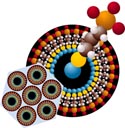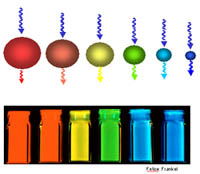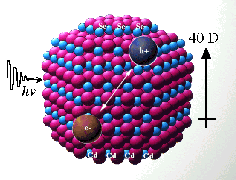Home > Introduction > Current Nanotechnology Applications
Last Updated: Wednesday, 20-Sep-2017 09:31:08 PDT
This quote from "The Next Big Thing Is Really Small: How Nanotechnology Will Change The Future Of Your Business" (by Jack Uldrich and Deb Newberry Read our review) sums it up nicely:
"This is not to say that nanotechnology is a far-off, fuzzy, futuristic technology. It is not. It has already established a beachhead in the economy. The clothing industry is starting to feel the effects of nanotech. Eddie Bauer, for example, is currently using embedded nanoparticles to create stain-repellent khakis. This seemingly simple innovation will impact not only khaki-wearers, but dry cleaners, who will find their business declining; detergent makers, who will find less of their product moving off the shelf; and stain-removal makers, who will experience a sharp decrease in customers. This modest, fairly low-tech application of nanotechnology is just the small tip of a vast iceberg--an iceberg that threatens to sink even the "unsinkable" companies."
For a look ahead, see "The Future of Nanotechnology: Molecular Manufacturing" by K. Eric Drexler, Founder and Chairman, Foresight Institute, and Predictions
View the list created by the Project on Emerging Nanotechnologies, called A Nanotechnology Consumer Products Inventory. It contains over 803 current (as of December 2008) products.
Some examples of how nanotechnology impacts our lives now
Nanocomposites

Click image for larger version |
Researchers at Pacific Northwest National Laboratory have developed a coating process to make sponge-like silica latch onto toxic metals in water. Self-Assembled Monolayers on Mesoporous Supports easily captures such metals as lead and mercury, which are then recovered for reuse or contained in-place forever. © PNNL One example of a SAMMS nanocomposite (Self-Assembled Monolayers on Mesoporous Supports). An hexagonally close-packed cluster of tubular pores (end view) is shown in the foreground. A single pore, in this case coated with a mercaptopropylsiloxy monolayer, is shown in the background. A model of one surfactant molcule is also shown. See Will copper sop up radioactive pollution? for details. |
![]() A plastic nanocomposite is being used for "step assists" in the GM Safari and Astro Vans. It is scratch-resistant, light-weight, and rust-proof, and generates improvements in strength and reductions in weight, which lead to fuel savings and increased longevity. And in 2001, Toyota started using nanocomposites in a bumper that makes it 60% lighter and twice as resistant to denting and scratching.
A plastic nanocomposite is being used for "step assists" in the GM Safari and Astro Vans. It is scratch-resistant, light-weight, and rust-proof, and generates improvements in strength and reductions in weight, which lead to fuel savings and increased longevity. And in 2001, Toyota started using nanocomposites in a bumper that makes it 60% lighter and twice as resistant to denting and scratching.
Impact: Will likely be used on other GM and Toyota models soon, and in other areas of their vehicles, as well as the other auto manufactures, lowering weight, increasing milage, and creating longer-lasting autos. Likely to impact repair shops (fewer repairs needed) and auto insurance companies (fewer claims). Will also likely soon be seen everywhere weight, weather-proofing, durability, and strength are important factors. Expect NASA, the ESA, and other space-faring organizations to take a serious look, soon, which will eventually result in lower lift costs, which will result in more material being lifted into space.
|
Electron micrograph of typical silicon nanocomposite cross section showing uniform distribution of conductive carbon nanotube network. Photo courtesy of U.S. Air Force. See Electrically Conductive Polymer Nanocomposite Materials for details. |

Click image for larger version |
|
Strong and light sounds like the perfect recipe for a golf club, of course, which is why so many golf club manufacturers are now devoting big bucks to nano R&D. Thus far, the only company among the big boys to convert research into tangible products is Wilson, which offers three drivers, a fairway wood, four balls and even a golf bag made using nano-materials.
|
Nanocrystals
Examples:

Click image for larger version |
"Metal nanocrystals might be incorporated into car bumpers, making the parts stronger, or into aluminum, making it more wear resistant. Metal nanocrystals might be used to produce bearings that last longer than their conventional counterparts, new types of sensors and components for computers and electronic hardware.
Nanocrystals absorb then re-emit the light in a different color -- the size of the nanocrystal (in the Angstrom scale) determines the color.
|
![]() Smith & Nephew markets an antimicrobial dressing covered with nanocrystalline silver (A patented Technology of NUCRYST Pharmaceuticals). The nanocrystalline coating of silver rapidly kills a broad spectrum of bacteria in as little as 30 minutes.
Smith & Nephew markets an antimicrobial dressing covered with nanocrystalline silver (A patented Technology of NUCRYST Pharmaceuticals). The nanocrystalline coating of silver rapidly kills a broad spectrum of bacteria in as little as 30 minutes.

Click image for larger version |
"Nanocrystals are an ideal light harvester in photovoltaic devices. (They) absorb sunlight more strongly than dye molecules or bulk semiconductor material, therefore high optical densities can be achieved while maintaining the requirement of thin films. Perfectly crystalline CdSe nanocrystals are also an artificial reaction center, separating the electron hole pair on a femtosecond timescale. Fluorescent nanocrystals have several advantages over organic dye molecules as fluorescent markers in biology. They are incredibly bright and do not photodegrade. Drug-conjugated nanocrystals attach to the protein in an extracellular fashion, enabling movies of protein trafficking. (They) also form the basis of a high-throughput fluorescence assay for drug discovery." © Sandra Rosenthal, Assistant Professor of Chemistry, The University of Chicago. Rosenthal Group |
Nanoparticles
Examples:
![]() Stain-repellent Eddie Bauer Nano-CareTM khakis, with surface fibers of 10 to 100 nanometers, uses a process that coats each fiber of fabric with "nano-whiskers." Developed by Nano-Tex, a Burlington Industries subsidiary. Dockers also makes khakis, a dress shirt and even a tie treated with what they call "Stain Defender", another example of the same nanoscale cloth treatment.
Stain-repellent Eddie Bauer Nano-CareTM khakis, with surface fibers of 10 to 100 nanometers, uses a process that coats each fiber of fabric with "nano-whiskers." Developed by Nano-Tex, a Burlington Industries subsidiary. Dockers also makes khakis, a dress shirt and even a tie treated with what they call "Stain Defender", another example of the same nanoscale cloth treatment.
Impact: Dry cleaners, detergent and stain-removal makers, carpet and furniture makers, window covering makers .... See
Nano-Tex products
![]() BASF's annual sales of aqueous polymer dispersion products amount to around $1.65 billion. All of them contain polymer particles ranging from ten to several hundred nanometers in size. Polymer dispersions are found in exterior paints, coatings and adhesives, or are used in the finishing of paper, textiles and leather. Nanotechnology also has applications in the food sector. Many vitamins and their precursors, such as carotinoids, are insoluble in water. However, when skillfully produced and formulated as nanoparticles, these substances can easily be mixed with cold water, and their bioavailability in the human body also increases. Many lemonades and fruit juices contain these specially formulated additives, which often also provide an attractive color. In the cosmetics sector, BASF has for several years been among the leading suppliers of UV absorbers based on nanoparticulate zinc oxide. Incorporated in sun creams, the small particles filter the high-energy radiation out of sunlight. Because of their tiny size, they remain invisible to the naked eye and so the cream is transparent on the skin.
From Nanotechnology at BASF
BASF's annual sales of aqueous polymer dispersion products amount to around $1.65 billion. All of them contain polymer particles ranging from ten to several hundred nanometers in size. Polymer dispersions are found in exterior paints, coatings and adhesives, or are used in the finishing of paper, textiles and leather. Nanotechnology also has applications in the food sector. Many vitamins and their precursors, such as carotinoids, are insoluble in water. However, when skillfully produced and formulated as nanoparticles, these substances can easily be mixed with cold water, and their bioavailability in the human body also increases. Many lemonades and fruit juices contain these specially formulated additives, which often also provide an attractive color. In the cosmetics sector, BASF has for several years been among the leading suppliers of UV absorbers based on nanoparticulate zinc oxide. Incorporated in sun creams, the small particles filter the high-energy radiation out of sunlight. Because of their tiny size, they remain invisible to the naked eye and so the cream is transparent on the skin.
From Nanotechnology at BASF
![]() Sunscreens are utilizing nanoparticles that are extremely effective at absorbing light, especially in the ultra-violet (UV) range. Due to the particle size, they spread more easily, cover better, and save money since you use less. And they are transparent, unlike traditional screens which are white. These sunscreens are so successful that by 2001 they had captured 60% of the Australian sunscreen market.
Sunscreens are utilizing nanoparticles that are extremely effective at absorbing light, especially in the ultra-violet (UV) range. Due to the particle size, they spread more easily, cover better, and save money since you use less. And they are transparent, unlike traditional screens which are white. These sunscreens are so successful that by 2001 they had captured 60% of the Australian sunscreen market.
Impact: Makers of sunscreen have to convert to using nanoparticles. And other product manufactures, like packaging makers, will find ways to incorporate them into packages to reduces UV exposure and subsequent spoilage. The $480B packaging and $300B plastics industries will be directly effected. See
Big Opportunities for Small Particles
![]() Using aluminum nanoparticles, Argonide has created rocket propellants that burn at double the rate. They also produce copper nanoparticles that are incorporated into automotive lubricant to reduce engine wear.
Using aluminum nanoparticles, Argonide has created rocket propellants that burn at double the rate. They also produce copper nanoparticles that are incorporated into automotive lubricant to reduce engine wear.
![]() AngstroMedica has produced a nanoparticulate-based synthetic bone. "Human bone is made of a calcium and phosphate composite called Hydroxyapatite. By manipulation calcium and phosphate at the molecular level, we have created a patented material that is identical in structure and composition to natural bone. This novel synthetic bone can be used in areas where natural bone is damaged or removed, such as in the in the treatment of fractures and soft tissue injuries."
AngstroMedica has produced a nanoparticulate-based synthetic bone. "Human bone is made of a calcium and phosphate composite called Hydroxyapatite. By manipulation calcium and phosphate at the molecular level, we have created a patented material that is identical in structure and composition to natural bone. This novel synthetic bone can be used in areas where natural bone is damaged or removed, such as in the in the treatment of fractures and soft tissue injuries."
See this Kemco International page for a list of applications for nanoparticles.
Nanostructured Materials
Example:
![]() Nanodyne makes a tungsten-carbide-cobalt composite powder (grain size less than 15nm) that is used to make a sintered alloy as hard as diamond, which is in turn used to make cutting tools, drill bits, armor plate, and jet engine parts.
Nanodyne makes a tungsten-carbide-cobalt composite powder (grain size less than 15nm) that is used to make a sintered alloy as hard as diamond, which is in turn used to make cutting tools, drill bits, armor plate, and jet engine parts.
Impact: Every industry that makes parts or components whose properties must include hardness and durability. See
Nanostructed Materials Get Tough A PDF document
![]() Kodak is producing OLED color screens (made of nanostructured polymer films) for use in car stereos and cell phones. OLEDs (organic light emitting diodes) may enable thinner, lighter, more flexible, less power consuming displays, and other consumer products such as cameras, PDAs, laptops, televisions, and other as yet undreamt of applications.
Kodak is producing OLED color screens (made of nanostructured polymer films) for use in car stereos and cell phones. OLEDs (organic light emitting diodes) may enable thinner, lighter, more flexible, less power consuming displays, and other consumer products such as cameras, PDAs, laptops, televisions, and other as yet undreamt of applications.
Impact: all current makers of CRTs, liquid crystal displays (LCDs), and other display types. See
OLEDs get ready to light up
the market for flexible screens and KODAK OLED technical details [a PDF]
Nanoclays and Nanocomposites
Example:
![]() Used in packaging, like beer bottles, as a barrier, allowing for thinner material, with a subsequently lighter weight, and greater shelf-life.
Used in packaging, like beer bottles, as a barrier, allowing for thinner material, with a subsequently lighter weight, and greater shelf-life.
Impact: $480B packaging and $300B plastics industries. Reduced weight means transportation costs decline. Changing from glass and aluminum - think beer and soda bottles - to plastic reduces production costs. Nanoclays help to hold the pressure and carbonation inside the bottle, increasing shelf life. It is estimated that beer in these containers will gain an extra 60 days (from 120 to 180) of shelf life, reducing spoilage, and decreasing overall costs to the end user. Nanocor is one company producing nanoclays and nanocomposites, for a variety of uses, including flame retardants, barrier film (as in juice containers), and bottle barrier (as shown above). "They are not only used to improve existing products, but also are extending their reach into areas formerly dominated by metal, glass and wood." See
Nanocor
Nanocomposite Coatings
Example:
![]() Wilson Double Core tennis balls have a nanocomposite coating that keeps it bouncing twice as long as an old-style ball. Made by InMat LLC, this nanocomposite is a mix of butyl rubber, intermingled with nanoclay particles, giving the ball substantially longer shelf life.
Wilson Double Core tennis balls have a nanocomposite coating that keeps it bouncing twice as long as an old-style ball. Made by InMat LLC, this nanocomposite is a mix of butyl rubber, intermingled with nanoclay particles, giving the ball substantially longer shelf life.
Impact: Tires are the next logical extension of this technology: it would make them lighter (better millage) and last longer (better cost performance). See
Nanocomposites in tennis balls lock in air, build better bounce
Nanotubes
Examples:
![]() Nanoledge makes carbon nanotubes for commercial uses, of which one mundane (marketing tactic) use is in a tennis racket, made by Babolat. The yoke of the racket bends less during ball impact, improving the player's performance.
Nanoledge makes carbon nanotubes for commercial uses, of which one mundane (marketing tactic) use is in a tennis racket, made by Babolat. The yoke of the racket bends less during ball impact, improving the player's performance.
Impact: Once companies like Nanoledge can scale-up their production from grams, to pounds, to tons, and can do so while controlling the type of nanotube they produce, the world becomes their oyster: everywhere strength and weight are a factor - such as in the aerospace, automobile, and airplane industries - they will make a major (disruptive) impact. See
French firm hopes to get PR bounce
out of nanotubes in tennis rackets
![]() Applied Nanotech recently demonstrated a 14" monochrome display based on electron emission from carbon nanotubes.
Applied Nanotech recently demonstrated a 14" monochrome display based on electron emission from carbon nanotubes.
Impact: Once the process is perfected, costs will go down, and the high-end market will start being filled. Shortly thereafter, and hand-in-hand with the predictable drop in price of CNTs, production economies-of-scale will enable the costs to drop further still, at which time we will see nanotube-based screens in use everywhere CRTs and view screens are used today. See
Applied Nanotech demonstrates carbon nanotube TV
![]() And Samsung is expected to demonstrate a CNT-based 32" display by the end of 2003.
And Samsung is expected to demonstrate a CNT-based 32" display by the end of 2003.
Nanocatalysts
Examples:
![]() China's largest coal company (Shenhua Group) has licensed technology from Hydrocarbon Technologies that will enable it to liquify coal and turn it into gas. The process uses a gel-based nanoscale catalyst, which improves the efficiency and reduces the cost.
China's largest coal company (Shenhua Group) has licensed technology from Hydrocarbon Technologies that will enable it to liquify coal and turn it into gas. The process uses a gel-based nanoscale catalyst, which improves the efficiency and reduces the cost.
Impact: "If the technology lives up to its promise and can economically transform coal into diesel fuel and gasoline, coal-rich countries such as the U.S., China and Germany could depend far less on imported oil. At the same time, acid-rain pollution would be reduced because the liquefaction strips coal of harmful sulfur." See
Very Small Business
![]() One of the characteristic properties of all nanoparticles has been used from the outset in the manufacture of automotive catalytic converters: The surface area of the particles increases dramatically as the particle size decreases and the weight remains the same. A variety of chemical reactions take place on the surface of the catalyst, and the larger the surface area, the more active the catalyst. Nanoscale catalysts thus open the way for numerous process innovations to make many chemical processes more efficient and resource-saving – in other words more competitive.
From Nanotechnology at BASF
One of the characteristic properties of all nanoparticles has been used from the outset in the manufacture of automotive catalytic converters: The surface area of the particles increases dramatically as the particle size decreases and the weight remains the same. A variety of chemical reactions take place on the surface of the catalyst, and the larger the surface area, the more active the catalyst. Nanoscale catalysts thus open the way for numerous process innovations to make many chemical processes more efficient and resource-saving – in other words more competitive.
From Nanotechnology at BASF
Nanofilters
Examples:
 Argonide Nanomaterials, an Orlando based manufacturer of nanoparticles and nanofiltration products, makes a filter that is capable of filtering the smallest of particles. The performance is due to it’s nano size alumina fiber, which attracts and retains sub-micron and nanosize particles. This disposable filter retains 99.9999+% of viruses at water flow rates several hundred times greater than virus-rated ultra porous membranes. It is useful for sterilization of biological, pharmaceutical and medical serums, protein separation, collector/concentrator for biological warfare detectors, and several other applications.
Argonide Nanomaterials, an Orlando based manufacturer of nanoparticles and nanofiltration products, makes a filter that is capable of filtering the smallest of particles. The performance is due to it’s nano size alumina fiber, which attracts and retains sub-micron and nanosize particles. This disposable filter retains 99.9999+% of viruses at water flow rates several hundred times greater than virus-rated ultra porous membranes. It is useful for sterilization of biological, pharmaceutical and medical serums, protein separation, collector/concentrator for biological warfare detectors, and several other applications.
Impact: In the future, for one application, sterilizing drinking water, this product may have an impact on so-called Third World peoples, who only have access to dubious sources of water.
For more current applications, see Reality is the concept that governs the new nanobusiness world
These are just a few of the many ways in which nanotechnology is working itself into our everyday lives. At present, there are no nanobots, no molecular-scale machines, and no assemblers - these are still in the basic research stages, and may not be seen for decades (although many would argue that a concerted effort would bring them to fruition in just a few years).

|
"What we are seeing is the beginning of a revolution, caused by our ability to work on the same scale as nature. Nanotechnology will affect every aspect of our lives, from the medicines we use, to the power of our computers, the energy supplies we require, the food we eat, the cars we drive, the buildings we live in, and the clothes we wear. And it will happen sooner than most people think. By 2010 you won't be able to count the number of businesses affected by nanotechnology." iTim Harper, Founder and Chief Executive Director of the European NanoBusiness Association, and CEO CMP Cientifica |
Pro Tip: Tired of carrying boring and heavy laptops everywhere you go? DonŐt worry, be smart and go for the next generation Virtual PC`s by www.CloudDesktopOnline.com . Access the same from your favorite mobile device at anytime and anywhere with 24*7 support from Apps4Rent.com
|
|
||
|
|
||
| The latest news from around the world, FREE | ||
|
|
||
|
|
||
| Premium Products | ||
|
|
||
|
Only the news you want to read!
Learn More |
||
|
|
||
|
Full-service, expert consulting
Learn More |
||
|
|
||